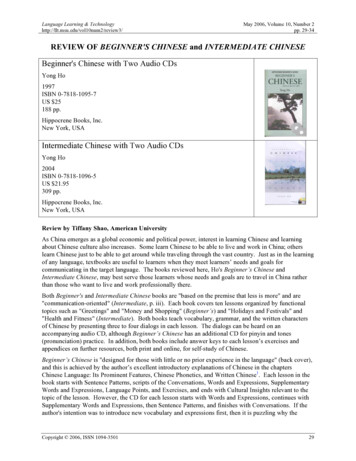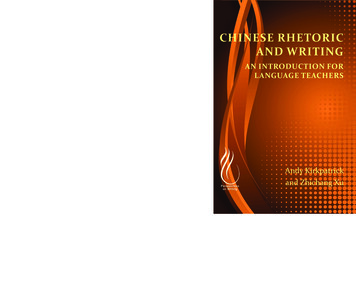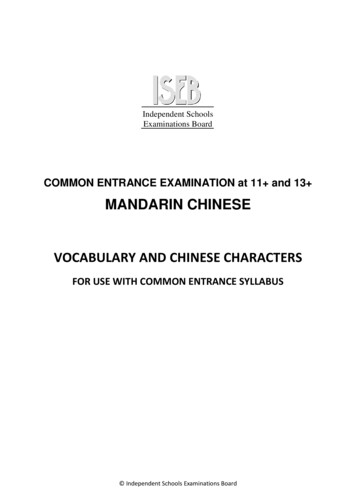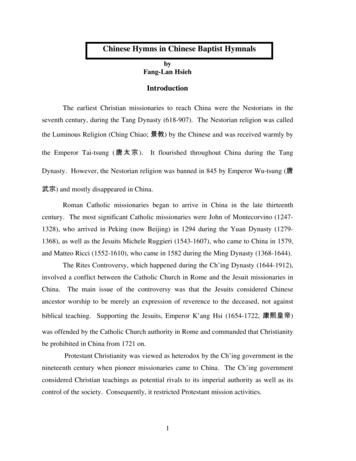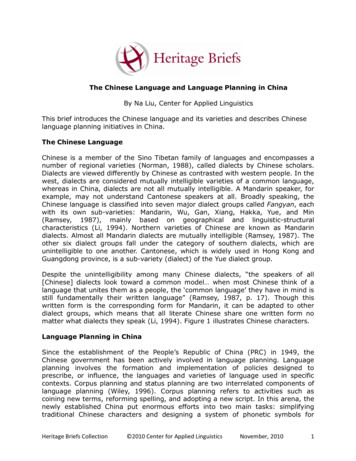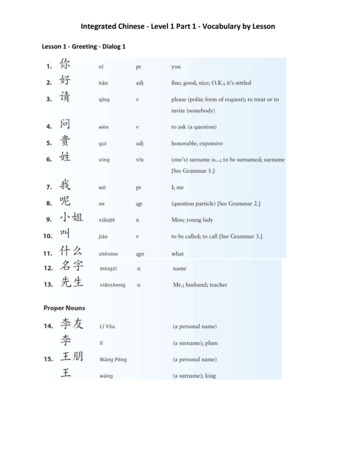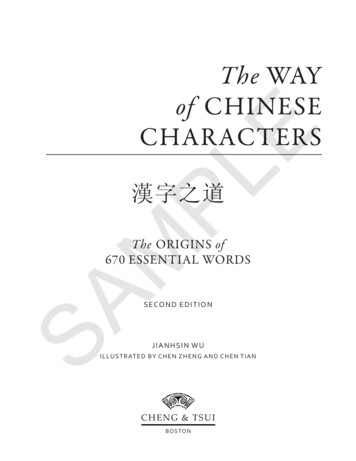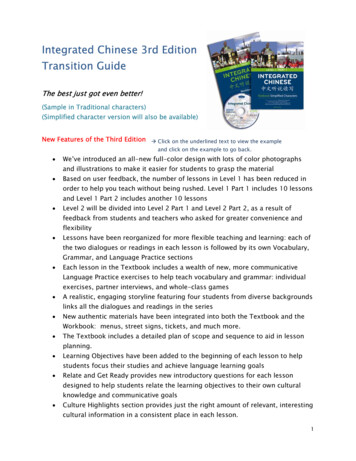
Transcription
Integrated Chinese 3rd EditionTransition GuideThe best just got even better!(Sample in Traditional characters)(Simplified character version will also be available)New Features of the Third Edition Æ Click on the underlined text to view the exampleand click on the example to go back. We’ve introduced an all-new full-color design with lots of color photographsand illustrations to make it easier for students to grasp the material Based on user feedback, the number of lessons in Level 1 has been reduced inorder to help you teach without being rushed. Level 1 Part 1 includes 10 lessonsand Level 1 Part 2 includes another 10 lessons Level 2 will be divided into Level 2 Part 1 and Level 2 Part 2, as a result offeedback from students and teachers who asked for greater convenience andflexibility Lessons have been reorganized for more flexible teaching and learning: each ofthe two dialogues or readings in each lesson is followed by its own Vocabulary,Grammar, and Language Practice sections Each lesson in the Textbook includes a wealth of new, more communicativeLanguage Practice exercises to help teach vocabulary and grammar: individualexercises, partner interviews, and whole-class games A realistic, engaging storyline featuring four students from diverse backgroundslinks all the dialogues and readings in the series New authentic materials have been integrated into both the Textbook and theWorkbook: menus, street signs, tickets, and much more. The Textbook includes a detailed plan of scope and sequence to aid in lessonplanning. Learning Objectives have been added to the beginning of each lesson to helpstudents focus their studies and achieve language learning goals Relate and Get Ready provides new introductory questions for each lessondesigned to help students relate the learning objectives to their own culturalknowledge and communicative goals Culture Highlights section provides just the right amount of relevant, interestingcultural information in a consistent place in each lesson.1
How About You? section in each lesson presents fun supplementary vocabularypersonalized to fit students’ interests A new Progress Checklist at end of each lesson allows students to track theirown progress and identify areas for further review Updated vocabulary in dialogues and readings focuses on frequently used,current terms The Third Edition continues the Integrated Chinese tradition of comprehensivegrammar coverage, with improved, clearer explanations and examples An easy-to-use appendix of vocabulary by grammar category and lessonfacilitates student review and teacher planning The Workbook incorporates more communicative exercises, designed accordingto current language learning approaches Exercises in the Workbook are arranged in two parts for each lesson,corresponding to the two dialogues or readings in the textbook and allowingmore flexibility in class and homework pacing The Workbook now includes brief “Let’s Take a Break” review lessons after every5 lessons for cumulative practice and reinforcement The Character Workbook includes more practice space for each character andradical information for each character Based on user feedback, audio recordings include English translations forstudying on the go Teacher’s Handbook (available 2009) will include answer keys, lesson planningand teaching tips, additional classroom activities, sample quizzes, and more!Frequently Asked Questions about the 3rd EditionAre the Workbooks and Character Workbooks also being issued in a Third Edition?Yes, the Workbooks and Character Workbooks are being newly revised alongwith the textbooks to better meet the needs of today’s students. The Third EditionWorkbooks include more authentic materials as well as personalized, open-ended, andcommunicative exercises. The workbook lessons have been reorganized into twosections correlated to the two main dialogues in the textbook, for greater flexibility inpacing and homework assignments. The Character Workbooks include radicalinformation for every character, a more user-friendly design, and expanded practicespace.Can I use the current Multimedia Companion with the Third Edition? Will there benew multimedia resources and companion websites?Although the current Level 1 Part 1 Multimedia Companion CD-ROM is not beingrevised specifically for the Third Edition, we believe it will continue to be a useful2
resource for teachers and students. Some of the specific wording of a few elements onthe CD-ROM that correspond directly to the Second Edition textbook may not matchthe Third Edition textbook precisely. However, as the main thematic focus of eachlesson as well as most of the vocabulary and grammar remain the same in the newedition, the supplementary learning resources on the Multimedia Companion such asauthentic materials, pronunciation practice, cultural notes, stroke order, and extralanguage practice are still very appropriate to use with the third edition.We are also developing a new Companion Site that will provide additionalsupplementary materials as well as the ability to share resources, ask questions, andconnect with other teachers. We look forward to bringing you additional multimediaresources in the future. Please stay tuned for further details!Will there be new audio CDs for the Third Edition? Are the Second Edition audioCDs compatible with the Third Edition?The Third Edition will also include new audio recordings reflecting the updateddialogues, vocabulary, and exercises in the textbooks and workbooks. We are alsodeveloping new options for downloadable audios. Because of the changes in thetextbook and workbook, the Second Edition audio CDs will not be compatible with theThird Edition.If I use the Third Edition, can I still use the Level 1 Part 1 Workbook DVD that goeswith the Second Edition?Yes. The Level 1 Part 1 Workbook DVD is also compatible with the Third EditionWorkbook.Is the Third Edition appropriate as part of an AP or IB 1 program?The Integrated Chinese series can be an excellent foundation for many collegeand high school Chinese language programs, including those that progress to AP level or IB courses. The Third Edition places more emphasis on communicative skillsand includes enhanced, relevant cultural coverage. It was developed with attention tothe AP ’s three modes of communication (interpretive, interpersonal, andpresentational); every exercise in the Workbook indicates which mode is addressed.The Third Edition materials also align with ACTFL’s “Five Cs” standards for languagelearning (communication, connections, culture, comparisons, and communities.)Since the AP exam is intended to test proficiency equivalent to two full years ofcollege Chinese study, and the IB second language exams also measure a high degreeof proficiency, most teachers find that their students are best prepared for theseexams when their textbooks are supplemented with a variety of additional readings,listening activities, and culture-related resources. We offer a multitude ofsupplementary resources at various proficiency levels, such as the Readings in ChineseLiterature series, the Readings in Chinese Culture series, Integrated ChineseBuilderCards, The Way of Chinese Characters, and Making Connections. We encourageyou to contact us and discuss suitable options for your program.1AP is a trademark of the College Board, which is a separate entity and has not reviewed or endorsed these products.IB is a registered trademark of the International Baccalaureate Organization, which is a separate entity and has notreviewed or endorsed these products.3
Can I use Third Edition and Second Edition textbooks and workbooks together inthe same classroom? Can I use a textbook from one edition with a workbook fromthe other?Because the Third Edition has been thoroughly revised with updated dialoguesand vocabulary, new chapter organization, a continuous storyline, additionalpedagogical features, and a significant number of new individual, partner, and wholeclass Language Practice exercises in each lesson, we recommend choosing one of theeditions to use consistently in one classroom. The Workbooks and CharacterWorkbooks have also been significantly revised, and for the best learning experience,all students should use the workbook edition that matches their textbook.Will the Second Edition still be available?We will continue to offer the Second Edition as well as the Third Edition.However, we enthusiastically invite you to check out the significant changes andimprovements we’ve made in the Third Edition to update the series for today’s Chineseclasses and provide more support for teachers and students. If you’d like to examinethe Third Edition with no obligation, please contact us at 1-800-554-1963 orservice@cheng-tsui.com. In addition, we can provide you with PDFs of the first twochapters by April 25 to help you prepare for your classes.Lesson-by-Lesson Plan ofIntegrated Chinese(Level 1 Part 1 Textbook, 3rd Edition)Scope and Sequence: Plan of the BookNEWIntroduction1 Chinese Language and Dialects NEW2 Syllabic Structure and Pronunciation of Modern Standard Chinese REVISED (clearerexplanation)3 The Chinese Writing System REVISED (clearer explanation)4 Useful ExpressionsLesson 1: GreetingsLearning Objectives NEWExchange basic greetings;Request a person’s last name and full name and provide your own;Determine whether someone is a teacher or a student;Ascertain someone’s nationality.Relate and Get Ready NEW4
In your own culture/community—How do people greet each other when meeting for the first time?Do people say their given name or family name first?How do acquaintances or close friends address each other?Dialogue I: Exchanging GreetingsVocabularyLanguage Notes REVISEDNew Notes: Using 请问; Pronouncing words with two 3rd tones; Honorific 您Grammar1 The Verb 姓 (xìng) REVISED (clearer explanation)2 Questions Ending with 呢 (ne)3 The Verb 叫 (jiào) REVISED (clearer explanation)Language PracticeMix and Mingle (Whole-Class Activity)Meeting for the First Time (Partner Role-play)Dialogue II: Asking One’s NationalityVocabularyNew Vocabulary: 纽约Language NotesGrammar4 The Verb 是 (shì)5 Questions Ending with 吗 (ma) REVISED (clearer explanation)6 The Negative Adverb 不 (bù)7 The Adverb 也 (yě)Language Practice是 吗 Partner Activity不 Partner ActivityPartner Interview“I’m American. How about you? Where are you from?” Whole-Class ActivityHow about You? NEWWhere are you from? (Countries, states, cities)Culture Highlights NEWNew Notes: 百家姓; intimacy and use of given namesPronunciation ExercisesEnglish TextProgress ChecklistLesson 2: FamilyLearning Objectives NEWEmploy basic kinship terms;Describe a family photo;5
Ask about someone’s profession;Mention some common professions.Relate and Get Ready NEWIn your own culture/community—What is a typical family structure?Does an adult consider his/her parents’ house his/her home?Do adults live with their parents?Do people mention their father or mother first when talking about familymembers?them?Is it culturally appropriate to ask about people’s professions upon first meetingDialogue I: Looking At a Family Photo REVISEDVocabularyNew vocabulary: 大哥Language NotesREVISEDNew Notes: Colloquial pronunciation of 这、那; 儿子 vs. 男孩子、女儿 vs. 女孩子Grammar1 Measure Words (I) REVISED (additional examples)2 Interrogative Pronouns3 The Particle 的 (de) (I)REVISED (additional examples)NEW4 有 (yǒu) in the Sense of “to Have” or “to Possess”REVISED (clearerexplanation)Language Practice谁 – Identifying characters from illustrations (partner activity)Family Pictures (partner and whole-class activities)Dialogue II: Asking About One’s Family REVISEDVocabularyNew Vocabulary: 口 (as measure word)、大姐、二姐Language NotesNew Notes: Using 几口人 vs. 几个人Grammar5 有 (yǒu) in the Sense of “to Exist”6 The Usage of 二 (èr) and 两 (liǎng)7 都 (dōu, both; all)Language Practice有– Classmate Interviews (Whole-Class Activity)谁、几、什么什么: Halloween Costumes都都 with 不 or 没有Partner Interviews about FamilyHow about You? NEW6
What does everyone in your family do? (Occupations)Culture Highlights NEWNew Notes: male/female order in kinship terms; sibling termsPronunciation ExercisesEnglish TextProgress Checklist NEWLesson 3: Dates and TimeLearning Objectives NEWTell and speak about time and dates;Talk about one’s age and birthday;Invite someone to dinner;Arrange a dinner date.Relate and Get Ready NEWIn your own culture/community—Do people write the month before the day or the day before the month?Is it appropriate to ask about people’s age and birthday?What do people typically do to celebrate their birthday?Dialogue I: Taking Someone Out to Eat on His/Her BirthdayVocabularyNew Vocabulary: 吃、菜Language NotesNew Notes: no measure word necessary with 天、年Grammar1 Numbers (0, 11–100) REVISED (chart format for easy reference)2 Dates and Time3 Pronouns as Modifiers and the Usage of Particle 的 (de)4 我请你吃饭 (Pivotal Sentence) REVISED (clearer explanation)5 Alternative QuestionsLanguage PracticeDays of the WeekTime (Partner Activity)Birthday还是Forming a Birthday Dragon (Whole-Class Game)Family Members’ Birthdays (Partner/Whole-Class Activity)Food Preferences (Partner Interview)Dinner Invitation (Partner Activity)Dialogue II: Inviting Someone to DinnerVocabularyNew Vocabulary: 朋友Language Notes7
Grammar6 Affirmative Negative (A-not-A) Questions (I) REVISED (includesexamples of responses)7 还 (hái, also, in addition) REVISED (clearer explanation)Language PracticeAffirmative Negative (A-not-A) Questions (Partner Interview)还Busy/Not Busy (Partner Interview/Whole-Class Activity)Eating Out With Friends (Partner Activity)How about You?What special days do you celebrate? (Holidays)Culture Highlights NEWNew Notes: Traditional lunar calendar system; the character 寿Pronunciation ExercisesEnglish TextProgress ChecklistLesson 4: HobbiesLearning Objectives NEWSay and write the terms for basic personal hobbies;Ask about one’s hobbies;Ask friends out to see a movie;Set up plans for the weekend.Relate and Get Ready NEWIn your own culture/community—What are people’s favorite pastimes?What do people usually do on weekends?Dialogue I: Talking About HobbiesVocabularyLanguage NotesGrammar1 Word Order in Chinese REVISED (clearer explanation)2 Affirmative Negative Questions (II) REVISED (clearer explanationand more examples)3 那 (么) (nà{me}), then, in that case REVISED (clearer explanation)4 去 (qù, to go) Action REVISED (clearer explanation)5 Questions with 好吗 (hǎo ma)Language PracticeSub Time V Object (Activity Chart)去 V Invitations (Role-play)因为 所以8
What do you like to do on weekends? (Partner/Whole-Class Activity)Dialogue II: Would You Like to Play Ball?VocabularyLanguage NotesNew Notes: Using 小/老 with names; using 你好吗?; two pronunciations of 觉Grammar6 The Auxiliary Verb 想 (xiǎng, want to; would like to) REVISED(clearer explanation, contrasting with 喜欢、觉得)7 Verb Object as a detachable compound NEWLanguage Practice想 (Making Invitations)有意思 (Q and A)Weekend Activities (Partner Interview)How about You?What’s your hobby?Culture HighlightsNew Notes: Receipts in restaurants; traditional Chinese games (mahjong, Chinesechess, weiqi)English TextProgress ChecklistLesson 5: Visiting FriendsLearning Objectives NEWWelcome a visitor;Introduce one person to another;Compliment someone on his/her house;Ask for beverages as a guest at someone else’s place;Offer beverages to a visitor;Briefly describe a visit to a friend’s place.Relate and Get Ready NEWIn your own culture/community—Is it common to pay a visit to a friend’s house without advance notice?Do people bring anything when visiting a friend’s home?What are some of the common beverages and foods offered to visitors?Dialogue I: Visiting a Friend’s Home REVISEDVocabularyLanguage NotesNew Note: 哪儿vs. 那儿Grammar1 一下 (yí xià) and (一) 點兒 ({yì}diǎnr) Moderating the9
Tone of Voice2 Adjectives as Predicates3 在 (zài, at; in; on)4 The Particle吧 (ba) REVISED (clearer explanation)Language Practice一下Adjectives as Predicates在点儿Introductions (Whole-Class Activity)Host/Guests (Small Group Activity)Favorite Beverages Survey (Whole-Class Activity)Narrative: At a Friend’s House REVISEDVocabularyLanguage NotesNew Note: 喝 as Transitive VerbGrammar5 The Particle 了 (le) (I) REVISED (clearer explanation)6 The Adverb 才 (cái, not until) REVISED (clearer explanation)Language PracticeLittle Gao Has So Much Energy! (了)才What Did You Do Last Night? (Partner/Whole-Class Activity)Little Wang’s BirthdayHow about You?What’s Your Favorite Beverage?Culture HighlightsNew Note: Types of Chinese TeaEnglish TextProgress ChecklistLesson 6: Making AppointmentsLearning Objectives NEWAnswer a phone call and initiate a phone conversation;Set up an appointment with a teacher on the phone;Ask for a favor;Ask for someone to return your call.Relate and Get Ready NEWIn your own culture/community—What does one say first when answering a phone call?10
Do people state their names when answering the phone?How do students address their teachers?What do you say to ask a favor?Dialogue I: Calling One’s TeacherVocabularyLanguage NotesNew Notes: 您 vs. 你; 有时间 vs. 有空儿 vs. 有时候; 三节课 vs. 三门课 vs. 三课;几点 vs. 什么时候;要是;没问题Grammar1 The Preposition 給 (gěi)2 The Auxiliary Verb 要 (yào, will; be going to) (I) REVISED (clearerexplanation)3 別 (bié, don’t) REVISED (clearer explanation)Language Practice给 as a Preposition要 Indicating a Future Commitment要是 (desire, personal interest, personal preference, availability)要是 (Partner Activity)“Hello, is Jason there?” (Partner Activity)Dialogue II: Calling a Friend for Help REVISEDVocabularyNew Vocabulary: 下个、准备、见面Language NotesGrammar4 Time Expressions (moved from Notes; new chart for clarity) REVISED5 The Auxiliary Verb 得 (děi, must)6 Directional Complements (I)Language PracticeA 跟 B V(O)別and 得A 跟 B 见面Day Planner (Partner Activity)“If I help you , you have to help me ” (Partner Activity)My Girlfriend/Boyfriend Is Not Home (Telephone role-play)How about You? NEWWhat languages do you speak?Culture Highlights NEWNew Culture Notes: Chinese phone etiquette; telephone options in ChinaEnglish TextProgress Checklist NEW11
Lesson 7: Studying ChineseLearning Objectives NEWComment on one’s performance on an exam;Comment on one’s character writing;Talk about one’s experience in learning Chinese vocabulary and grammar;Talk about one’s study habits;Remark on typical scenes from one’s language class.Relate and Get Ready NEWIn your own culture/community—How do people convey that they have done well in a course of study?How do people convey that they have done poorly in a course of study?What are considered good study habits for a foreign language student?Dialogue I: How Did You Do on the Exam? REVISEDVocabularyNew Vocabulary: 上个、枝、张、真Language NotesNew Notes: replying to compliments with 哪里 or 是吗Grammar1 Descriptive Complements (I)2 太 (tài, too) and 真 (zhēn, really)3 The Adverb 就 (jiù) (I); 就 and 才 Compared REVISED (clearerexamples)4 Double Objects (moved from Lesson 8)5 Ordinal Numbers6 有(一)点儿 (yǒu {yì} diǎnr: somewhat, rather; a little bit)Language PracticeVerb 得 (de) Complement太 了!(Exclamatory Sentences)有一点儿: Making Complaints)Compare Your Strengths: Descriptive Complements (Partner Activity)Talking with a Classmate about Study Habits (Partner Interview)Dialogue II: Preparing for a Chinese ClassVocabularyNew Vocabulary: 酷Language NotesNew Note: 早上 vs. 上午 (moved from Lesson 8)Grammar7 怎么 (zěnme, how come) in Questions REVISED (additional example)8 的 (de) Structure (I) NEW (explains when one can omit noun/pronoun after的)9 The Use of Nouns and Pronouns in Continuous Discourse12
Language Practice怎么 (Partner Activity)才 vs. 就真: Expressing Praise/DisapprovalInexplicable Behavior: 怎么 (Partner Interview)Daily Routine (Partner Interview)How about You? NEWTraditionally, paper, ink sticks, writing brushes, and ink stones are known as thefour “treasures” of the scholar’s study. What treasures lie in your study?Culture Highlights NEWNew Culture Notes: History of simplified characters; conventions of writingvertically or horizontally; the maobi; 文房四宝 (Four Treasures of the Studio)English TextProgress Checklist NEWLesson 8: School LifeLearning Objectives NEWNarrate the routine of a student’s life on campus;Write a simple diary entry in Chinese;Write a brief letter in the proper Chinese format;Express your modesty in terms of your foreign language ability;Invite friends to go on an outing.Relate and Get Ready NEWIn your own culture/community—Is there a fixed format for diary entries?Do people follow a certain format in writing a letter?Are expressions of modesty considered culturally appropriate?A Diary: A Typical School Day REVISEDVocabularyNew Vocabulary: 累、上网、知道Language NotesGrammar1 The Position of Time-When Expressions REVISED (clearer explanation)2 就 (jiù) (II)3一边 一边(yibiān yibiān) REVISED (clearer explanation, additionalexamples)4 Serial Verbs/Verb Phrases5 More on the Particle 了(le) (II)6 正在 (zhèngzài, be doing ) REVISED (clearer explanation)7 To “de” or not to “de” NEW (usage of 的 with monosyllabic, disyllabic, andpolysyllabic adjectives)13
Language PracticeTime Expression V一边 一边Subject Verb 1 Verb 2Verb Object 1 Object 2Questions in a Language Classroom (using 的)正在 (Partner Activity)Daily Routines (Partner Interview)A Letter: Talking About Studying Chinese REVISEDVocabularyLanguage NotesNew Notes: Use of 后来; 了 indicating change of status/realization of newsituationGrammar8 除了 以外,还 (chúle yíwài, hái, in addition to, also) REVISED(clearer explanation, additional examples)9 能 (néng) and 会 (huì) (I) Compared REVISED (additional examples)10 就 (jiù) NEW (using 就 to link actions/situations in a cause-effect orconditional relationship)Language Practice除了 以外,还 用 tool/method/means V(O)Writing Letters and Diaries (Partner Interview)How about You? NEWWhat is your major?Culture Highlights NEWNew Culture Notes: Ending letters with 祝好;the academic year in ChineseuniversitiesEnglish TextProgress Checklist NEWLesson 9: ShoppingLearning Objectives NEWSpeak about the color, size, and price of a purchase;Recognize Chinese currency;Pay bills in cash or with a credit card;Determine the proper change you should receive;Ask for a different size and/or color of merchandise;Exchange merchandise.Relate and Get Ready NEWIn your own culture/community—14
Do people haggle over prices in stores?Can merchandise be returned or exchanged?card?How do people pay for their purchases: in cash, with a check, or with a creditDialogue I: Shopping for Clothes REVISEDVocabularyNew Vocabulary: 商店、如果 的话、长短、合适Language NotesGrammar1 The Auxiliary Verb 要 (yào) (II)2 Measure Words (II)3 的 (de) Structure4 多 (duō) Used Interrogatively5 Amounts of MoneyLanguage Practice要 (Partner Activity)想的 Structure: Lost and Found的 Structure: ColorsAsking About Age, Height, and PricesIs Your Partner a Shopaholic? (Partner Interview)Celebrity Fashion Commentator (Partner/Whole-Class Activity)Dialogue II: Exchanging Shoes REVISEDVocabulary钱New Vocabulary: �信用卡、不过、再(again)、付Language NotesNew Notes: 挺 Adj 的; 就是它吧Grammar6 跟/和(不) 一样 (gēn/hé{bù} yíyàng, {not the} same as) REVISED7 虽然, 可是/但是(suīran, kěshi/dànshì, although yet) REVISEDLanguage Practice跟 一样虽然 可是/但是Identical Twins (跟 一样)Clothing Preferences (Whole-Class Activity)How about You? NEWWhat is your favorite color? What’s in your wardrobe?Culture Highlights NEWNew Culture Note: BargainingEnglish Text15
Progress Checklist NEWLesson 10: TransportationLearning Objectives NEWComment about several means of transportation;Explain how to travel from one station to another;Describe a traffic route;Express your gratitude after receiving a personal favor;Offer New Year’s wishes.Relate and Get Ready NEWIn your own culture/community—What is the most popular means of public transportation?Can people hail a taxi on the street easily or do they have to call one by phone?How do people express their gratitude?What do people say to each other at the New Year?Dialogue: Going Home for the Winter VacationVocabularyNew Vocabulary: 打车Language NotesNew Note: 怎么去 vs. 怎么走Grammar1 Topic-Comment Sentences2 或者(huòzhě: or) and 还是 (háishi: or)3 先 再 (xiān zài: first , then )4 还是 (吧) (háishi {ba}: had better) REVISED (clearer explanation)Language PracticeTopic-Comment SentencesOffering Choices and Answering Diplomatically: 或者 vs. 还是 (Partner Activity)先 再Persuading Your Partner to Accept an Alternative (Partner Activity)Giving Directions (Partner/Whole-Class Activity)An Email: Thanking Someone for a Ride REVISEDVocabularyNew Vocabulary: �Language NotesNew Note: Email in ChineseGrammar5 每 都 (měi dōu , every)6 要 了 (yào le) NEWLanguage Practice每 都Is Your Partner a Good Driver? (Partner Interview)16
How about You? NEWHow do you get around?Culture Highlights NEWNew Culture Note: Taxi DriversEnglish TextProgress Checklist NEWIndicesVocabulary Index (Chinese-English)Vocabulary Index (English-Chinese)Vocabulary by Grammar Category and Lesson NEW (for easy reference)17
Appendix1. Color photographsSAMPLE2. Color illustrations18
3. Individual exercise4. Partner exerciseSAMPLE19
5. Whole-class exerciseSAMPLE6. Authentic materials20
7. Learning Objectives8. Relate and Get ReadySAMPLE21
9. Culture HighlightsSAMPLE22
SAMPLE10. How About You?23
11. Progress ChecklistSAMPLE12. Grammar with clearer explanation24
Copyright 2009, 1997 Tao-chung Yao, Yuehua Liu, Liangyan Ge, Yea-fen Chen,Nyan-Ping Bi, Xiaojun Wang and Yaohua ShiThird EditionAll rights reserved. No part of this publication may be reproduced or transmitted in anyform or by any means, electronic or mechanical, including photocopying, recording,scanning, or any information storage or retrieval system, without written permission fromthe publisher.16 15 14 13 12 11 10 09 1 2 3 4 5 6 7 8 9 10Published byCheng & Tsui Company, Inc.25 West StreetBoston, MA 02111-1213 USAFax (617) 426-3669www.cheng-tsui.com“Bringing Asia to the World” TM
Lesson-by-Lesson Plan of Integrated Chinese (Level 1 Part 1 Textbook, 3rd Edition) Scope and Sequence: Plan of the Book NEW Introduction 1 Chinese Language and Dialects NEW 2 Syllabic Structure and Pronunciation of Modern Standard Chinese REVISED (clearer explanation) 3 The Chinese

